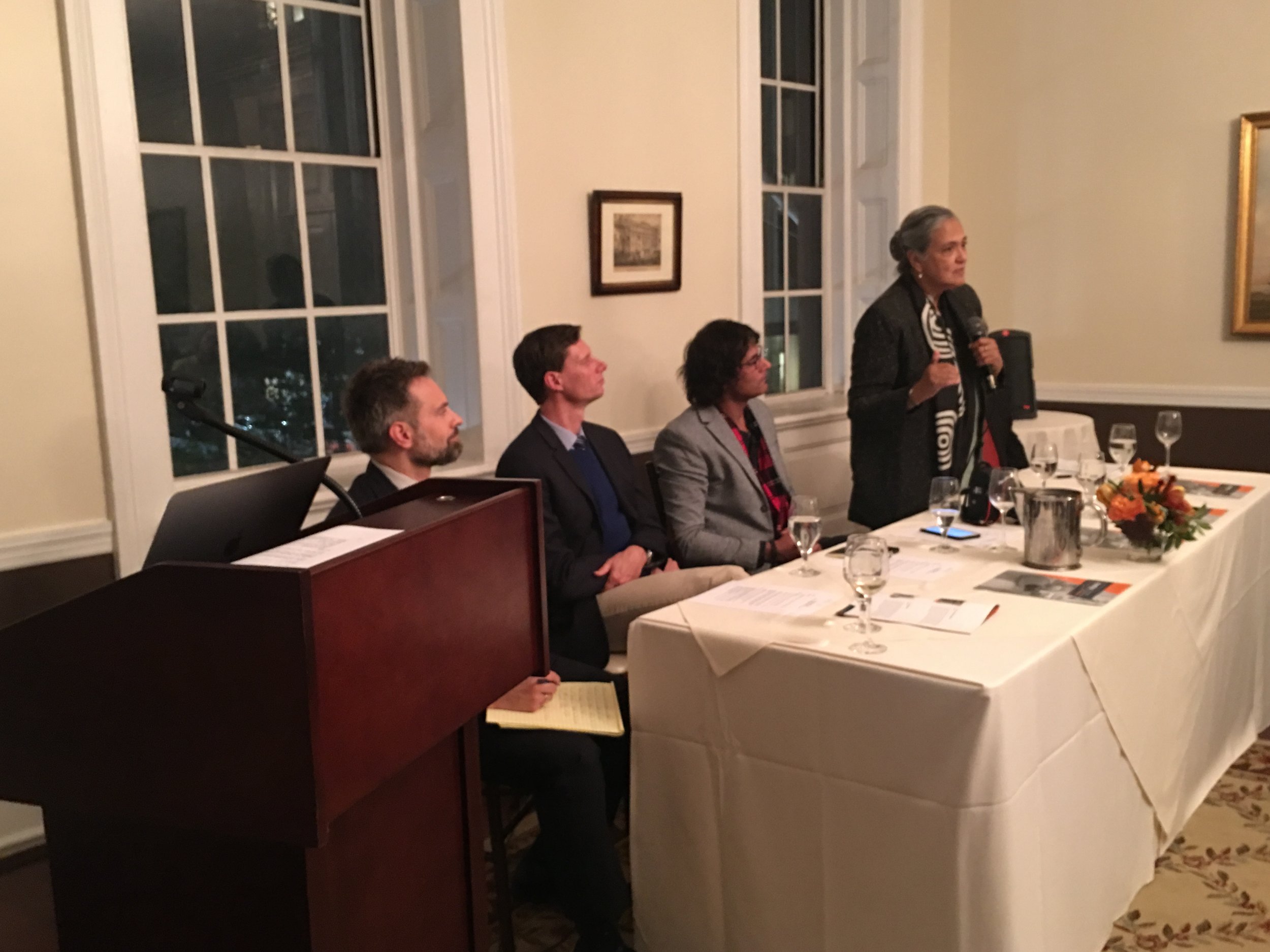Riding Populist Waves: Where Trump and Modi Find Common Ground
U.S. President Donald Trump and India Prime Minister Narendra Modi may have some differences in their leadership styles and values, but the two share common ground when it comes to their rise in popularity in conservative nationalist movements in their countries. The Media Project recently hosted an event in New York City featuring a panel of experts to discuss the topic of "Riding Populist Waves: Where Trump and Modi Find Common Ground". Five panelists identified the similarities and differences between the two leaders and examined the role that populism played in helping both of them rise to power.
Panelists Paul D. Glader, Markus Spieker, Vishal Arora, Jennifer Arul and Dr. Paul Marshall compare President Donald Trump to India Prime Minister Narendra Modi.
TMP's Executive Director, Paul D. Glader, opened the evening's conversation by defining populism as “the support for the concerns of the ordinary people.” This laid the groundwork for the discussion of how Trump appealed so greatly to "ordinary" people, despite what many members of the media and pollsters predicted early in his candidacy.
“Trump pushed the buttons of morphine drops to the country’s pain points,” Glader said. “He advocated for those who were hurt by globalism in the Rust Belt. He took a stand against immigration and called for stronger border control, which resulted in higher numbers of voters who came forward to support him.”
Panelists agreed that globalism has had a similar impact in India. It was Modi’s strong stance on anti-globalism that played a major role in his election in 2014 and in his term as Prime Minister.
““Modi treats other religions as inferiors and he does so through legislation.””
Over 100 journalists, students and friends of The Media Project attended the Nov 9th event at India House in NYC.
“History books are being rewritten to everything foreign is 'bad',” said Markus Spieker, a political correspondent for German television who is based in India. “Modi treats other religions as inferiors and he does so through legislation.”
Spieker went on to describe how Modi is an openly Hindu nationalist and a member of the Hindu nationalist party, the Bharatiya Janata Party (BJP). Under the party's ideology, there has been a shift from globalism and tolerance to the extreme belief that Hindus are superiors compared to all other religions. India is home to the second largest Muslim population and religious tensions are a major concern at this time.
“There’s an atmosphere of fear,” Spieker said. “For example, there’s been lynching of Muslim kids who are suspected of eating cow meat.”
Spieker is referring to laws that are now in place that prohibit the selling of cow meat, an animal held sacred by Hindus. Legislation based in Hindu nationalism appears to be emboldening religious vigilante groups to act out in violence and attack anyone who adheres to other religions. Open conversion to Christianity is also being made illegal in India.
Meanwhile, in the U.S., the growth of nationalist and supremacist groups has also been on the rise since Trump was elected. Many white nationalist and supremacist groups cling to his ideology and claim Trump's politics as a symbol to promote their own agenda.
““Both stem from values being threatened...the tensions are rooted in a lack of identity, both nationally and religiously.””
The two leaders also share an open disdain towards the media. Both are active on social media and use platforms such as Twitter to communicate with their base. These platforms have served them well as a means to speak to their supporters and build a stronger following.
Vishal Arora, a New Delhi-based independent journalist, described in detail how Modi uses his control over the media in India to adhere to its “sense of tradition.” He described how the media in India is owned by big companies who function primarily to present Modi’s point of view and not the opposition's.
Dr. Paul Marshall, Wilson Professor of Religious Freedom at Baylor University, compares the leaderships of Trump and Modi
Jennifer Arul, a freelance broadcast journalist also based in India, agreed.
“Often you are told to give the point of view of the authorities,” she said. “Or they are told not to talk to you [journalists].” Arul goes on to describe how this also applies when giving comments about vigilante violence which is also prevalent in India.
So why do these racial and religious tensions exist in both India and the United States?
“Both stem from values being threatened,” said Dr. Paul Marshall, Wilson Professor of Religious Freedom at Baylor University and author of over 25 books on topics including religious freedom, religion and politics. "The tensions between nationalism and religious nationalism tensions are rooted in a lack of identity, both nationally and religiously.”
This conflict creates an environment where people feel threatened and often lash out in an effort to feel recognized and given a place in the world. In both the U.S. and India, the fight against globalism has resulted in emboldened groups rising up and fighting with nationalistic ideologies against anyone who believes differently than them, and religious freedom is brought into question along with blurred ideas of what nationalism really stands for.
Guests enjoy a cocktail reception at India House following the panel discussion.
This panel was sponsored by The Media Project and held at the India House in New York City, featuring academics, journalists and The Media Project's Board of Directors.




